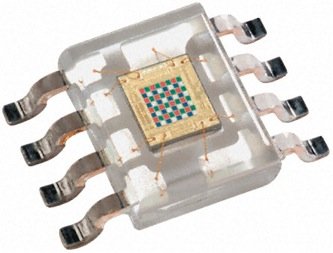Sensors provide effective quality control

A colour light sensor used in manufacturing
Image attributed to RSUK
In today's fast paced consumer society, it's important that products are manufactured as quickly and cheaply as possible. However, they still require stringent checks to be carried out to confirm items are correctly packaged or coloured. To do this work by hand would be extremely laborious and expensive. Therefore, a colour sensor is an ideal solution for automated processes.
What is a colour sensor?
A colour sensor can be used as part of a range of manufacturing processes to confirm the quality of a product before it's shipped. The sensor uses light to illuminate the product and this is then reflected back. The data received by the sensor is evaluated and stored. It's then checked against previous data and if they're within set tolerances, the product is allowed through.
This is a quick and simple method of controlling the quality standards during a high-speed automated process. The colour sensor can accurately process hundreds of products every second. This allows manufacturers to ensure their products meet the right standards, as well as keeping costs down. The consumer is then presented with a quality product without having to pay a high price.
No human could work effectively at this speed. The accuracy achieved by a colour sensor cannot be replicated in any other way. Using a machine rather than checking by eye means that there's less chance of something being missed. The data can be analysed in real-time, allowing manufacturers to see any large scale quality problems as soon as possible.
Colour sensors will work effectively on a range of materials, including textiles and plastic. They can also evaluate specific colour combinations, such as patterns, rather than just the individual colours.
What are colour sensors used for?
There are a range of industries that use a colour light sensor. They're regularly used in the manufacturing process to check a number of different settings. They can determine if packages have been filled the correct way up, ensuring that they can be viewed correctly within the store. A colour sensor can also determine if packaging has been filled with the correct product, for example, a particular colour of paint or flavour of juice.
The pharmaceutical industry is highly regulated and it's important that all products are filled and packaged correctly in order to meet these regulations. By fitting a colour sensor, they can be assured that blister packets contain the right number and type of pills. They can also check that a particular label has been added or that the right bar code is on the packaging.
Companies want their products to look good on the shelves. Therefore, it's important that the print quality of each individual item is the same. A colour sensor will notice any slight variations and where these don't meet the set tolerances, the product would be rejected.
Basically anything on or in the packaging that uses some form of colour can be checked through the use of a colour sensor. They can be used for everything, from basic sorting functions to more complex requirements.
More to Read:
Previous Posts:


